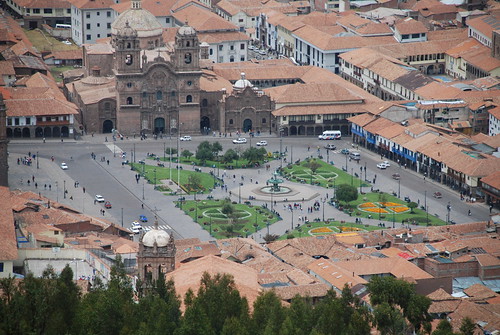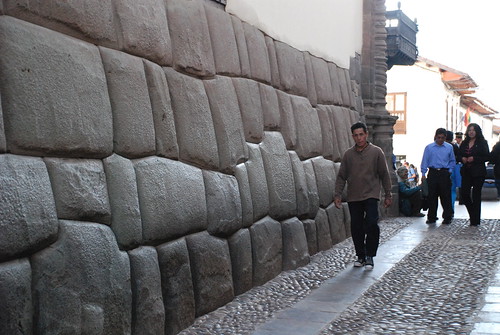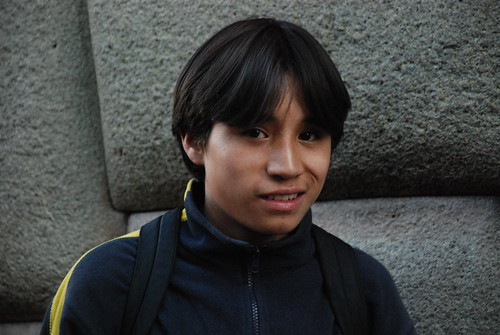
Cusco, Peru, is a beautiful old town of tile-roofed buildings. The oldest, narrowest streets are lined with imposing walls of perfectly cut stone, fit together by the Incas without mortar, still serving as the foundations for buildings. It's also a city filled with tourists and locals scurrying to profit off of their rich, western guests.
One afternoon while visiting, I had a rather unpleasant experience that I couldn't get out of my mind.

I was walking down a famous stone-lined street, Hatun Rumyoc, and saw a boy of maybe 12 trying to sell a European woman postcards or something. I had my camera out to take pictures of the impressive Inca stonework a few minutes later, when he came up and asked if I wanted to know which was the most famous stone, the one with 12 corners.

He introduced himself as Miquel, and when he told me he'd show me the rocks arranged like a jaguar around the corner, I knew I'd be obliged to tip him for showing me around.
After we got around to the other side of the block, where there were a couple of girls dressed up with a lamb to photograph, the tour was up and he pulled out his deck of paintings, little watercolors mounted on white greeting cards that he said he'd painted, though they were clearly not done by a 12 year old. I looked through them and asked how much. "Three for ten dollars," he said. There wasn't anything that interested me, certainly nothing that I'd want to fuss about keeping flat for the next three weeks. I told him I wouldn't be able to keep them safe, but thanked him for the tour and offered him a five-sole coin--about $1.70--for his 10-minute tour. He got persistent and said I needed to pay him by buying three of his paintings. When I declined, he said, "Five soles isn't enough, you should pay ten." When he started to argue, I told him to take it or leave it, that it was good money for ten minutes work. He replied, "It isn't a good tip. The boys in the street have to pay for their school," but he finally let me put the coin in his hand, mumbling, "In your country..." and left me feeling like crap instead of glad I'd met him, as I had just a minute earlier.
Now maybe I was being a stingy American, but from my point of view, there are a number of things wrong with this situation. First, he was working for a tip. He didn't show me that he even had paintings until after the "tour." Why should I suddenly be obliged to buy something when he'd been showing me around? The nature of a tip is that it's a bonus. Yes, it's sort of expected in that situation, though many tourists don't realize it until the hand has been stuck out--they think the locals are just being friendly until they realize it's all about money. If he'd wanted to negotiate a price, he should have done so ahead of time (just as I've learned it's necessary to do with South American taxi drivers.)
Perhaps I should have been more generous and pulled out ten soles to start with. In Ecuador I would have grabbed a one-dollar coin--even less. Considering that my college-educated Spanish tutors get paid $3 for an hour of teaching, that a half-hour taxi ride is $3.50 and that has to cover gas and car maintainance, what I gave him really seemed adequate when I initially pulled it out. So why didn't he think so?
Maybe he was being totally honest in saying that twice as much would be a good tip. Maybe that's what the average American or European traveler (on a bigger budget than me) gives. In which case, if the money's so easy, why not grab the small tip and scramble on to the next "client?" The thing is, I doubt it's so easy. Having "worked the street" in prosperous San Francisco, fund-raising for the Democrats in the 2004 election, I know that most of your time is spent either trying to get people to talk to you, or giving the spiel unsuccessfully. In his mind, Miguel must be thinking about the whole afternoon, the amount he brings in compared with how long he's out trying, while I think about only the ten minutes he spent talking to me. As a business, you do have to bring in enough money to make up for the down time, but if you have a lot of time without customers, you can't just charge the customers you do get extra to make up for what the missing customers would have paid.
My first reaction was that 12-year-old Miguel had a rather entitled attitude. By American standards, he's in no way privileged, but living in the tourist center of western--if not all of--South America, he's got a level of opportunity that few kids on the continent have. Riding the train across Ecuador, I saw little kids fighting viciously for the candies tossed their way by well-intentioned passengers. Hundreds of kids as young as four wander the squares of Quito trying to get you to let them shine your shoes for a quarter or 50 cents.
It raises a moral quandary. I think many Americans see the childhood poverty and feel guilty, or at least self-conscious. They probably do give bigger tips than they would if they were thinking about it as a business transaction. They think of themselves as being generous, not getting a good deal. What they're really paying for is to have their consciences appeased, not just for a good or service. Miguel, apparently, had picked up on this guilt, but the other side of it. He experiences it as entitlement. He doesn't just perceive an injustice, but has discerned that he deserves to be compensated. Maybe that's the case, but if so, the remedy isn't small reparations in the guise of business. A few dollars here and there does nothing to eradicate the poverty that pervades Latin America and much of the rest of the world (despite a few dollars being pretty significant when your family only makes $100 a month.)
The problem is that this "generosity" is supporting child labor. In fact, it probably encourages adults to send their kids into the streets before themselves because the "cute factor" is certainly profitable. If we saw elementary school kids bagging groceries, paid only in tips, in the U.S., we wouldn't tip them day after day; we'd report it to the authorities. Here thousands of kids are being exploited and we, western tourists who wouldn't tolerate it in our own countries, cough up the money that makes the exploitation viable.
Perhaps, though, young workers are inevitable. Miguel may need to be selling cards and giving tours, and, all things considered, it could be much worse. He's not in a sweat shop, and he's practicing his English and people skills. I can't blame him too much for going about business so badly, since the people in this part of South America, and Cusco in particular, don't get how to do business, especially given that their most profitable customers are Americans and Europeans.
One common job is being a tour guide, what Miguel was trying his hand at as a tactic for his real art-dealing job. In the United States, it's pretty unheard of to hire a personal guide to show you around. But here, it's cheap enough that I sometimes do it. Paying $20 each, along with 3 others, to have a couple of local guides take us overnight into the jungle was absolutely worth it. In Cusco though, Miguel's strategy seems pretty common. Men come up to you and just start talking, following you. They're hard to shake without being rude, and expect to be paid if you let them continue. Perhaps it's a profitable strategy for the individual, but I don't think it helps the economy of the town as a whole. I imagine that when people feel continually hassled, they're less likely to open their wallets in general. I certainly was. I appreciated that at the entry to one of the ruins I visited, they asked if I'd like a guide, and then, when I did say, "no thank you" it was no problem.
A similar strategy is employed by restaurants, where someone stands outside trying to get you to come in. I just feel hounded, and it causes me to walk quickly by places I would otherwise want to peek in and check out. This may be more of a cultural difference, but for me, I'd rather check out the menu without feeling pressured. So many stores, restaurants, and bars have tiny entrances and dark interiors that make you commit to entering before you can even find out if they sell anything you'd be interested in. Some big windows or a wide door would be a lot more effective than someone blocking the door and barking at you.
Even once inside an otherwise spacious store, the counter-productive pressure continues. I've gone into several department stores and had women follow me, standing right by or behind me as I tried to figure out what underwear would fit me without sizes in inches. I was inevitably made uncomfortable enough to walk out empty-handed. I suppose if you grow up with it, you see it as service, but in a tourist town, it would be indispensible for business owners, chambers of commerce, and tourist bureaus to understand that Americans are used to going into stores, even upscale department stores, and having to search for someone to serve them. It doesn't take much more than someone standing back, available, to make them feel like they're getting the kind of great service that makes them spread money freely. But it also doesn't take much more than that to make your customers feel uncomfortable, in which case they'll just want to leave.
There certainly are cultural differences, but I wonder if some of these lessons that I know apply to Americans would actually make good business sense anywhere. Isn't a store that you can see into with room to move around freely in going to be more inviting anywhere because of basic human psychology? For customers to come in and spend, they need to feel safe and comfortable. (Maslow's hierarchy of needs?) Very few small-scale businesses in South America seem to have figured out how to do this. I suspect one of the reasons American business is so successful--and American businesses do so well here in South America--is that the buildings are designed and staff trained to be inviting. McDonald's is successful all over the world, and though the menu changes a bit (rice as a side, ciabatta buns,) the walls are always mostly glass. Even if you've never been to McDonald's, you don't have to go inside to know what it's going to be like. Every U.S. chain is like this, open to the street, with staff waiting back or off to the side, encouraging you to come in and browse, no obligation, and as a result, we spend money on things we really don't need at stores that don't seem desperate for our business--the complete opposite of Calle Procurdores, the street full of restaurants I walked down the evening I met Miguel. I was half-looking for dinner, but felt so hassled that I skipped dinner and never walked down the street again.
It's sad, because they're desperate for business--the market over-saturated, but the costs so low that the tiniest profit makes staying open worth it--and they could get more business by working less hard for it, though perhaps it's something everyone would have to agree on. A quiet restaurant with just a menu might not be noticed, and sitting empty, wouldn't attract more customers.
At the same time, there are high-pressure sales people in the US--think car dealers. It must be an effective strategy sometimes. They won't let you leave without a car. But I know that this strategy convinced me not to buy a Hyundai and to pick the Toyota I now own instead. I also bet those places don't get a lot of repeat customers, since many must leave the transaction not feeling good about it. Maybe in a tourist town saturated with indistinguishable vendors, return business isn't very important--it's now or never.
Thus with Miguel. What did he have to lose by pushing me for a couple dollars more, even if it meant making me feel like a jerk whether it worked or not. The only thing was, it wasn't a calculated strategy for him. He was a kid and clearly emotionally invested in every sol. It was obvious that he walked away from me feeling jilted just as much as I did. When you're doing capitalism right, that doesn't happen.
No comments:
Post a Comment